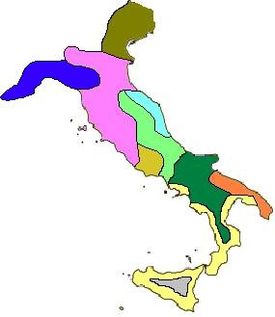- Umbri
-
The Umbri were an Italic people of ancient Italy.[1] A region called Umbria still exists and is currently occupied by Italian speakers. It is somewhat smaller than the ancient Umbria.
Most ancient Umbrian cities were settled in the 9th-4th centuries BC on easily defensible hilltops. Umbria was bordered by the Tiber and Nar rivers and included the Appennine slopes on the Adriatic. The ancient Umbrian language is a branch of a group called Oscan-Umbrian, which is related to the Latino-Faliscan languages (Buck, 1904).
Contents
Early references
Pliny the Elder wrote concerning the folk-etymology of the name:
The Umbrian people are thought the oldest in Italy; they are believed to have been called Ombrii (here, "the people of the thunderstorm," after ὅμβρος, "thunderstorm") by the Greeks because they survived the deluge (literally "the inundation of the lands by thunderstorms, imbribus). The Etruscans vanquished 300 Umbrian cities[2]
Religion
During the 6th–4th centuries BC, Umbrian communities constructed rural sanctuaries in which they sacrificed to the gods. Bronze votives shaped as animals or deities were also offered. Umbrian deities include Feronia, Valentia, Minerva Matusia and Clitumnus. The Iguvine Tables were discovered in 1444 at Gubbio, Italy. Composed during the 2nd or 3rd centuries BC, they describe religious rituals involving animal sacrifice.[3]
Political structure
Two men held the supreme magistracy of uhtur and were responsible for supervising rituals. Other civic offices included the marone, which had a lower status than uhtur, and a religious position named kvestur. The Umbrian social structure was divided into distinct groups probably based upon military rank. During the reign of Augustus, four Umbrian aristocrats became senators. Emperor Nerva’s family was from Umbria.[4]
According to Guy Jolyon Bradley, " The religious sites of the region have been thought to reveal a society dominated by agricultural and pastoral concerns, to which town life came late in comparison to Etruria."[5]
Roman influence
Throughout the 9th-4th centuries BC, imported goods from Greece and Etruria were common, as well as the production of local pottery.
The Romans first made contact with Umbria in 310 BC and settled Latin colonies there in 299 BC, 268 BC and 241 BC. They had completed their conquest of Umbria by approximately 260 BC. Incorporation into the Roman state occurred during the 3rd century BC when some Umbri were given full citizenship or citizenship without the right to vote. Also during the 3rd century BC about 40,000 Romans settled in the region. The Via Flaminia linking areas of Umbria was complete by 220 BC. Cities in Umbria also contributed troops to Rome for its many wars. Umbrians fought under Scipio Africanus in 205 BC during the Second Punic War. The Praetorian Guard recruited from Etruria and Umbria. The Umbri played a minor role in the Social War and as a result were granted citizenship in 90 BC. Roman veterans were settled in Umbria during the reign of Augustus.[6]
Archaeological sites
The towns of Chianciano and Chiusi (Umbrian: Camars) near modern Siena contain traces of Umbrian habitation dating to the 7th or 8th centuries BC. The inhabitants of Camars left their city after a defeat by Pelasgians; they subsequently crossed the Appennines to found a new city, Cameria or Camerta (modern Camerino).
Perugia was an ancient Umbrian center until it was overrun by the Etruscans c. 5th century BC.
Assisi, called Asisium by the Romans, was an ancient Umbrian site on a spur of Mount Subasio. Myth relates that the city was founded by Dardanus in 847 BC.
See also
References
- ^ Pliny, Natural History Vol 3, chap. 19.
- ^ Pliny the Elder, Book III, chap. 19, paragraphs 112-113. Also at wikisource latina
- ^ Poultney, 1959
- ^ Bradley, 2000
- ^ http://books.google.com/books?id=8OOUx1ETc3AC&printsec=frontcover&dq=ancient+umbria&hl=en&src=bmrr&ei=CR8VTvLHJqHN0AHuq6Uu&sa=X&oi=book_result&ct=result&resnum=1&ved=0CCkQ6AEwAA#v=onepage&q=indo%20european&f=false
- ^ Bradley, 2000
Sources
- Bradley, Guy (2000). Ancient Umbria. State, culture, and identity in central Italy from the Iron Age to the Augustan era. Oxford: Oxford University Press.
- Buck, Carl Darling (1904). A Grammar of Oscan and Umbrian. Boston: Ginn and Company Publishers.
- Domenico, Roy P.. Regions of Italy: A Reference Guide to History and Culture. Greenwood Publishing Group, 2001. pp. 367–371.
- Pliny (1961). Natural History with an English translation in ten volumes by H. Rackham. Cambridge: Harvard University Press.
- Poultney, James Wilson (1959). The Bronze Tables of Iguvium. American Philological Association, Number XVIII.
Categories:
Wikimedia Foundation. 2010.

